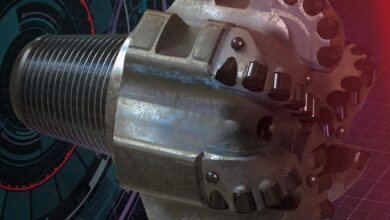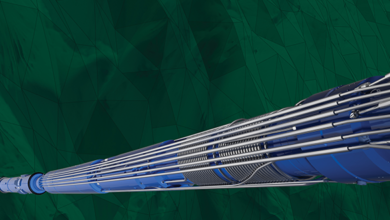D&C Tech Digest
Innovative method used to create new platform slot
Hughes Christensen helped a customer in the Congo accomplish a world-first by utilizing an innovative technique to create an additional slot on a platform in the Foukanda offshore field.
The objective was to simultaneously drill and case off over 60 m (197 ft) of shallow formations using casing while drilling (CwD) to enable the drilling of additional wells from the existing platform, which had no further slot availability. A 30-in. diverter conductor pipe was positioned from the platform to the seabed. The pipe was manufactured with a pre-cut window and a 2° deflector inside that would allow drilling to be diverted from the existing eight directional wells, avoiding any collision.
The recommended drilling assembly consisted of an EZCase 24-in. bit and 20-in. casing rotated using a drive sub. The 66-m (217-ft) section was drilled successfully with returns to the sea. The EZCase bit and 20-in. casing were cemented in place, and the casing was connected to the surface wellhead as usual.
ROP was controlled and averaged 7.5m/hr (24.6 ft/hr) on-bottom drilling, and the bit was drilled out in just over three hours with a 16-in. GTX-CPT311 TCI bit.
Baker Oil Tools installs industry’s first RAM Multilateral System on Alaska’s North Slope
Baker Oil Tools has achieved the first successful installation of a new rotating, self-aligning multilateral (RAM) system on Alaska’s North Slope. The RAM system is the industry’s first tool that can continuously rotate liners and screens into extended-reach lateral bores while simultaneously landing multilateral junctions.
“On Alaska’s North Slope, extended-reach multilateral wells are necessary to ensure maximum contact with trapped oil pools. The RAM System enables operators to efficiently construct long, horizontal multilaterals, a major technical challenge,” said Alex Ortiz, wellbore construction manager for Baker Oil Tools. “The RAM system is an evolutionary tool based on our HOOK Hanger and FORMation Junction technologies.”
On the North Slope, a major operator found that improving recovery from the sand horizon just below the permafrost (3,000-ft depth) required extended-reach multilaterals with horizontal departures of more than 5:1 ratios and liner lengths of more than 8,000 ft. Continuous rotation was necessary to get the drill pipe and liner to total lateral depth in these long horizontal sections.
The RAM system was used to land two multilateral junctions and simultaneously rotate liners to bottom. Liner length of the upper lateral was 8,689 ft, and total depth was 17,035 ft (3,212 ft TVD). All project objectives were met, resulting in the world’s first successful RAM multilateral system and providing an economical option for developing the large viscous oil reserves in Alaska.
Separately, Baker Oil Tools has run and deployed its first hydraulic whipstock in deepwater with a sidetrack well on the Matterhorn platform. Following a competitor’s gravel pack failure, the operator wanted to re-enter the production zone from the same casing. Water depth was 2,800 ft (853 m), and the deviation in the 9 5/8-in. casing at the whipstock setting depth was 61°. The operator also wanted a hydraulic set one-trip system that did not require a cast iron bridge plug. Baker Oil Tools deployed a G2 Hydraulic WindowMaster system and completed the window in 5.5 hours, then drilled 40 ft of additional formation with flawless execution.
INTEQ runs first MagTrak service
Baker Hughes INTEQ recently ran the first MagTrak job in the Utue field in Nigeria. The 8½-in. deviated hole section was drilled using the 6 ¾-in. AutoTrak Rotary Closed Loop System, LithoTrak and MagTrak services. Cutting primarily through shale with intermittent sand, this run drilled 1,727 ft (526.4 m) from 9,206 ft (2,805.9 m) to 10,933 ft (3,332.3 m) measured depth. The client’s primary reason for running this LWD package was to compare the porosity readings of the new MagTrak service with the proven LithoTrak measurements and, if acceptable, qualify the MagTrak tool for future applications. Although real-time communication with the MagTrak system was lost, the tool obtained a complete set of memory data, which compared well with LithoTrak porosity readings.
World’s deepest conventional mooring system installed
Murphy Sabah Oil and partner Petronas Carigali has set a record for installing the world’s deepest conventional mooring system. The companies worked with InterMoor to moor Diamond Offshore’s Ocean Rover semisubmersible on the Buntal exploration well offshore Sabah, East Malaysia.
The rig was moored at depths that required two of the anchors to be set in more than 8,000 ft of water. The deepest leg of the eight-leg conventional mooring system reached 8,431 ft.
Each mooring leg, deployed using the anchor-handling vessels Normand Ivan and Normand Atlantic, consisted of a 10-metric ton Stevpris anchor with the rig’s self-contained wire and chain.
World’s longest extended-reach well drilled offshore Qatar
Transocean’s jackup GSF Rig 127 has set a world record for the longest extended-reach well ever drilled at 40,320 ft (12,289 m) MD with a 35,770-ft (10,902-m) horizontal section. The well was drilled offshore Qatar in 36 days and incident-free. The new record of 7.6 miles is also the first well in the history of offshore drilling that exceeds 40,000 ft (12,191 m). The well surpasses by approximately 2,000 ft the prior extended-reach record of 38,322 ft (11,680 m) MD set by another drilling contractor with a land rig on Sakhalin Island earlier this year.
The rig’s crew, working with the operator, Maersk Oil Qatar AS, overcame many constraints, including high drilling torque in the horizontal section. The Well BD-04A is in the Al-Shaheen field offshore Qatar. Crews used extensive deck-management planning and a supply boat to hold additional drill pipe so that the rig could stay within its variable deck load rating.
Worldwide, Schlumberger technology has contributed to six of the top seven extended-reach directional projects. The latest, drilled in the Al-Shaheen field offshore Qatar, reached a total depth of 40,320 ft. Total step-out distance from the surface location was 35,770 ft.
In all, the well set 10 records, including:
• Longest well ever drilled.
• Longest along-hole departure (37,956 ft).
• Longest 8 ½-in. section (35,449 ft).
• Highest ERD ratio (AHD/TVD): 10.485.
• Highest Directional Drilling Difficulty Index (DDI): 8.279.
• Deepest directional control.
• Deepest downlink, MWD transmission and LWD geosteering (40,320 ft).
• Deepest battery-less operation.
• Longest reservoir contact (35,449 ft).
• Longest open hole.
The 8 ½-in. horizontal section was drilled in two runs with the PowerDrive X5 and PowerDrive Xceed RSS. The TeleScope high-speed telemetry-while-drilling system transmitted geosteering information in real time and continuous measurements of parameters that affect drilling efficiency. The system also ensured that downlinking commands were received by the bottomhole assembly all the way to total depth. Continuous trajectory control enabled drillers to keep the wellbore within the 3-ft “sweet spot” of the 10-ft-thick reservoir 95% of the time.
For the first time, totally battery-less LWD triple combo equipment was used. The TeleScope, geoVISION and adnVISION systems were powered by a turbine generator driven by drilling fluid circulation.
The record-breaking performance involved a Schlumberger D&M team assigned to the customer for more than a year. Drilling engineers located in Maersk’s offices provided close collaboration, and Operation Support Center (OSC) engineers ensured clear communications and vital data were available for decision-making. Repair and maintenance personnel prepared and tested the equipment.
1st phase is completed in rigless subsea well intervention project in Australia
Phase one of a rigless intervention activity on Woodside’s Vincent project, offshore Western Australia, has been completed. This marks the first ever fully integrated rigless subsea well intervention project in the Asia Pacific region. TSMarine’s Perth subsidiary operates a multi-year service contract with Woodside, and this milestone project has seen TSMarine’s offshore well intervention vessel, the Havila Harmony, successfully deploy, install and test seven subsea trees and carry out wireline intervention on all seven wells. This is the first phase of a campaign that will include the installation and completion of up to 11 subsea trees in the Vincent field and a range of commissioning and decommissioning projects in region. This also was the first time the deployment and installation on wire of subsea xmas tress from a monohull vessel has taken place in the region. Similarly, it was the first time a subsea well intervention project has been carried out using wireline services from a monohull vessel in Australian waters.




